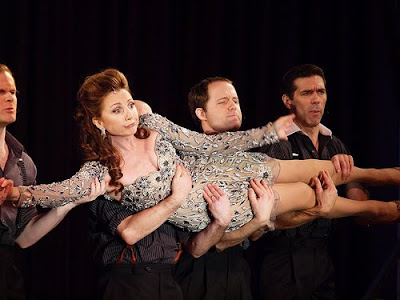I would like to call for a coronation in New York City. I don’t know if there are any statutes in the NY government that allow for such activity, or even whether her colleagues would appreciate my hubris, but if there is anyone who deserves to be crowned the Queen of Musical Comedy (at least this year) it is Donna Murphy, who experienced another in a series of career triumphs in this weekend’s Encores! revival of Anyone Can Whistle. If you missed her performance, I am legitimately sorry for you because it was the most scrumptious, delectable, laugh-out-loud hilarious musical comedy performance I’ve seen in the last several years.
Lusty, shallow, greedy, neurotic and deliriously oblivious, Murphy sashays through the evening like a Vegas nightclub diva, complete with a quartet of male dancers who follow her everywhere she goes. Her voice is in exceptional form and each one of her numbers was a pure knockout. Every nuance in her delivery, her physical movement, even the way she pronounces her own last name is enough to bust a gut. Her physicality is fearless, brash and just about the greatest thing since sliced bread. Every moment she is onstage you can’t help but watch her – she’s not only funny, but fascinating.
Murphy, coiffed by Gregg Barnes in an homage to the role’s originator Angela Lansbury (who insisted she play the part), is so winning that she would win every theatre award in sight were she eligible. It’s even more impressive when you think of her career trajectory: the bleak, depressive Fosca in Passion, the prim Mrs. Anna in The King and I, Ruth Sherwood in Wonderful Town and Phyllis in Follies. There are not many actresses with such extensive range and ability.
It bears mentioning that Ms. Murphy is not onstage alone. Sutton Foster is lots of fun as a Fay Apple, the uptight pragmatic nurse who can only let down her guard when dolled up like a French tart. She brings that now trademark belt to “There Won’t Be Trumpets” and offered a touching rendition of the title song. Raul Esparza flits around wildly as Hapgood, the would-be doctor who is actually a patient running the asylum. Edward Hibbert, Jeff Blumenkrantz and John Ellison Conlee provide enormous comic support as ‘Hoovah-Hoopah’s’ sidekicks, partners in crime (and possibly some more unmentionable extra-curricular activities).
This legendary flop played nine performances at the Majestic in 1964, an overreaching satire about a bankrupt city whose corrupt mayoress (and minions) concoct a phony miracle in order to capitalize on it. I won’t get too far into the plot as, well, with this show it doesn’t particularly matter. Laurents’ libretto is a meandering mess that tries too hard to lampoon everything imaginable. It seems that by trying to make the show all about everything that the creators inadvertently made it about nothing. David Ives made judicious cuts to the book, but to little avail: the piece as a whole is still unworkable and unsalvageable.
But there is still that score. Goddard Lieberson had the foresight to record the score in spite of the show’s closing. Sondheim, at this point, was primarily known as a lyricist and whose only Broadway composing credit was the smash hit A Funny Thing Happened on the Way to the Forum. It was in Anyone Can Whistle that Broadway had its first taste of the Sondheim style and sound, which would revolutionize the genre in 1970’s Company. The album turned the show into a cult favorite, keeping Sondheim’s music and lyrics alive.
In honor of the composer’s 80th birthday, Encores! offers the rare NY revival and it is highly doubtful this production could be bettered. Director-choreographer Casey Nicholaw, also responsible for the memorable Encores! concert of Follies three years ago, has staged the piece with winning originality, especially in the subtitled bedroom scene. His dances are especially polished. They culminate in a showstopping climax with the “Cookie Chase,” a comic ballet complete with butterfly nets and tumbles. It’s a zany, absurd piece that simultaneous recalls the Keystone Cops and Tchaikowsky and is utterly ingenious, and an homage to the work of Herbert Ross, the original choreographer.
This is one of the best I’ve seen at the City Center. However, if producers are thinking of transferring this one, I don’t think that would be a wise move. It’s unlikely that we’ll ever see a commercial production that could make the show work or make it as fun as this one. But this is the ideal Encores! experience: a show that wouldn’t ordinarily be revived. This one will be best remembered for its triumphant weekend. Let’s hope next season can produce such a winner. Now I just wonder who’ll we have to see about getting Donna Murphy onstage in that other Lansbury star vehicle, Mame.






